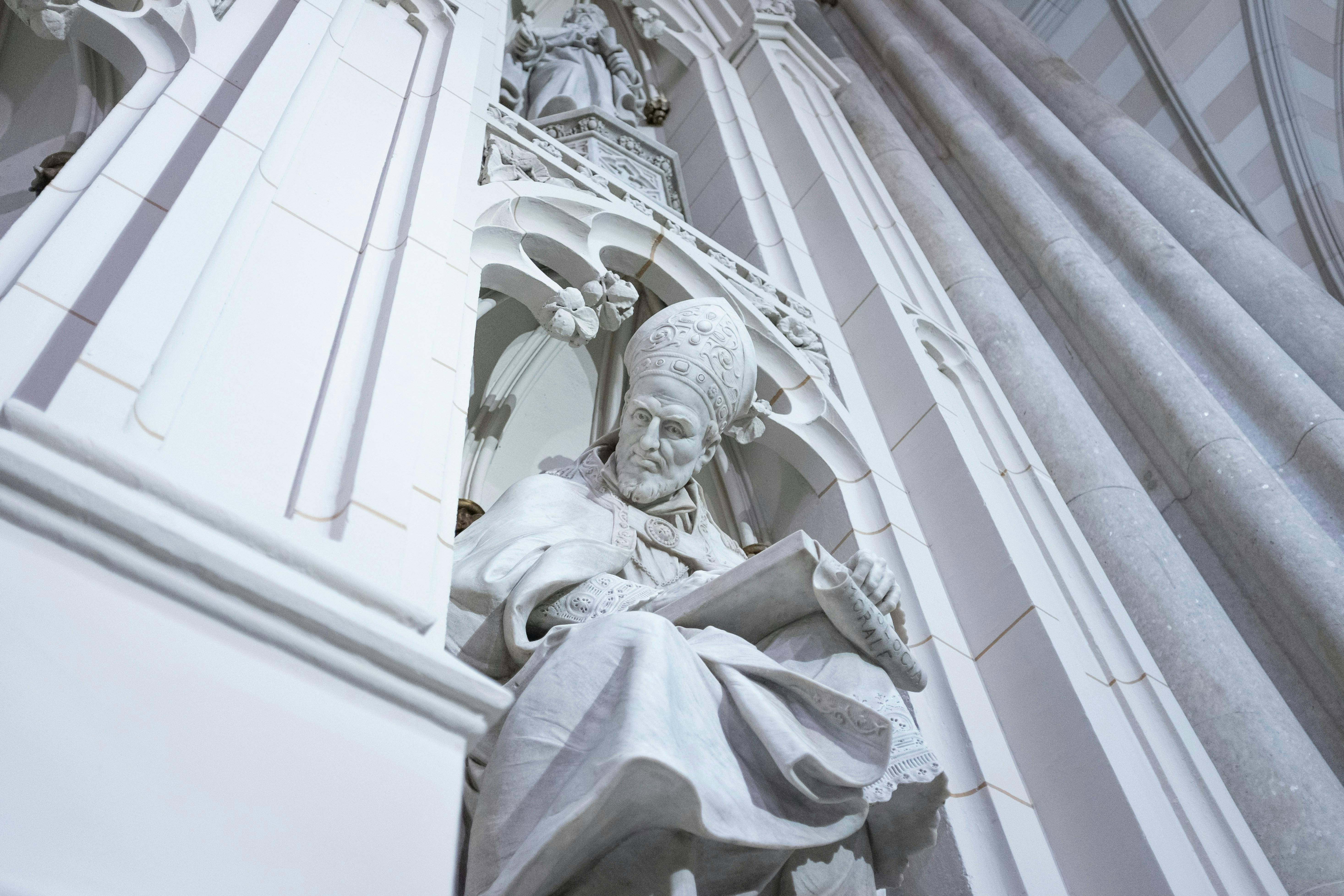Hiding just behind many of the holidays on our calendars are the lives of ancient followers of Jesus. We toss their names around without the faintest idea of how they lived, what they sacrificed, and how their faith sent shockwaves through time. This year, we’re doing something about that. The Holy Behind the Holiday is an ongoing series looking back at some prominent figures from the history of the Church and what their lives can still teach us today. Check out the first installment here.
Saint Patrick’s Day is an annual excuse for many to get decked out in green, pinch people they don’t like (or maybe it’s people they do like; I’m fuzzy on that detail), and swim in a sea of Guinness. Unsurprisingly, none of those things come into the story of the guy it was named after.
If you can believe it—and I love his day just as much as the next guy—Patrick’s actual life was even more impressive than how much dye it takes to turn the Chicago River green (only 40 pounds—see, that’s impressively little!).

Patrick was a priest and bishop who spent most of his life as a missionary at the end of the world—which was believed to be Ireland at that point in history. He’s associated with the shamrock and chasing snakes, though most of those particulars are likely embellishments added to the actual history as they were passed down over generations.
Unlike many early saints, we actually have a handful of writings from Patrick. From these, we can piece together some semblance of his life. And an incredible one it was. It goes something like this.
Patrick was born into a wealthy and religious family in Roman Britain (possibly Scotland). His grandfather was a priest, and his father was a deacon. But young Patrick didn’t have much interest in faith. He held it at bay, more concerned with the trifles that young boys chase.
Around the age of 16, Patrick’s life was turned upside down. He was kidnapped by raiding Irish pirates and taken back to the Emerald Isle, where he was sold as a slave. He was sent to work as a shepherd, spending long days and nights alone in the fields, watching over herds of sheep.

With nothing else to hold onto, he turned to the faith of his family. He passed the time out in the fields in prayer. Like the sun rising, he slowly realized that God was real, good, and still working.
After six years as a slave, Patrick was in the fields when he heard a voice. “You’ll go home soon,” the voice said, “Your ship is ready.”
Patrick had a choice to make. Should he run away from his master and risk being caught and punished? Or should he push forward into something better? The coast was some 200 miles away through land foreign to Patrick.
Now dedicated to his God, Patrick used the cover of night to slip away. When he finally reached the coast, he found a ship preparing to sail back to Britain. Surely, this was the ship that God had spoken to him about.
The only problem? The captain didn’t seem to agree.
No matter how hard Patrick tried to persuade the captain, he refused to take the runaway on board. Not knowing what else to do, Patrick walked away, praying as he went. He hadn’t gone more than a few paces when some of the sailors called him back. The captain had suddenly changed his mind.

They sailed for three days, but near the end, the ship was caught in a storm that blew it off course. When the waves settled, the ship was deposited on a shoreline no one recognized. The crew disembarked and wandered the wilderness for weeks, not knowing where to go. They saw no people, no cities, and, worst of all, no crops. The food rations were depleted, and the people were beginning to face the reality of starvation.
“If your God is so powerful,” the captain sneered, “Why doesn’t he help us?”
Patrick prayed to God, and as he finished, a herd of wild pigs began to rumble by. The sailors captured and killed whatever they could, harvesting enough meat for them all to eat their fill for two days. After this miracle, many of the sailors came to believe in the God of Patrick.
Patrick eventually made it back home. His parents and friends were surprised and delighted to see the young man return after so much time had passed. But not long after his return, Patrick had a strange dream. In his dream, a man from Ireland appeared to him, carrying a bundle of letters. He handed one to Patrick, and when he opened it, he could hear the voices of the Irish people saying, “Please, come back!”
Patrick committed himself to growing the faith he’d discovered in Ireland, studying to be a priest, and pursuing the goal of returning to the Emerald Isle—not as a slave, but as a missionary. And that’s precisely what he did.

Commissioned as one of the first missionaries to Ireland, a young Patrick set sail and never looked back. He spent the rest of his life introducing the Irish people to Jesus. He oversaw the construction of churches, established monasteries and convents, and worked tirelessly for the people who had imprisoned him as a teenager.
Legends say that Patrick taught the concept of the trinity—that God is three persons, but one God—using the three-leafed shamrock and that he purged the island of all snakes by driving them into the sea. I’m not sure if either of those stories is true, but it’s hard to argue with the lives that were changed. Some historians estimate Patrick started as many as 200 churches and baptized some 100,000 converts to Christianity during his lifetime in Ireland.
In his Confessions, Patrick wrote, “How did this happen in Ireland? Never before did they know of God except to serve idols and unclean things. But now, they have become the people of the Lord, and are called children of God.”
The answer to his question, which Patrick is too humble to share, is God moving through a life poured out for others. That’s how one man changed an entire island and why his legacy lives on to this day.
Patrick was committed, tireless, and a man of prayer. When he encountered a problem, he offered it to God and kept going. I want that kind of faith, and Patrick’s story makes it concrete for me. It’s not an x-factor you are born with. It’s a muscle developed only one way: pray, then move.
It is believed Patrick died on March 17th, 461 AD, a day associated with this man and the people he loved ever since.

On St. Patrick’s Day, when I raise a pint of Guinness in his honor, I’ll be thinking about this excerpt from his Confessions:
“I spend myself for you, so that you may have me for yours… I could wish to leave… to visit my home country and my parents. But I am bound in the Spirit, who assures that if I were to do this, I would be held guilty. And I fear, also, to lose the work which I began — not so much I as Christ the Lord, who told me to come here to be with these people for the rest of my life. May the Lord will it, and protect me.”
Like Joseph and Daniel in the Bible, who too were taken as slaves to a faraway country to do the work of God, Patrick stands as a shining example of God’s ability to use all things—with emphasis on all—for the good of those committed to Him and His mission.
As for you, you meant evil against me, but God meant it for good, to bring it about that many people should be kept alive, as they are today. (Genesis 50:20)
I, for one, will gladly raise a pint to that.
Disclaimer: This article is 100% human-generated.
Reflections to share? Got an idea for an article? Email us at articles@crossroads.net
Sources:
Saint Patrick, Jonathan Rogers, Thomas Nelson, 2010.
The Confessions of Saint Patrick, translated by Padraig McCarthy. Romans Road Media, 2015.
Stories of the Saints, Carey Wallace, Workman Publishing, 2018.
On this Day: 365 Amazing and Inspiring Stories about Saints, Martyrs and Heroes, Robert J. Morgan, Thomas Nelson, 1997.













